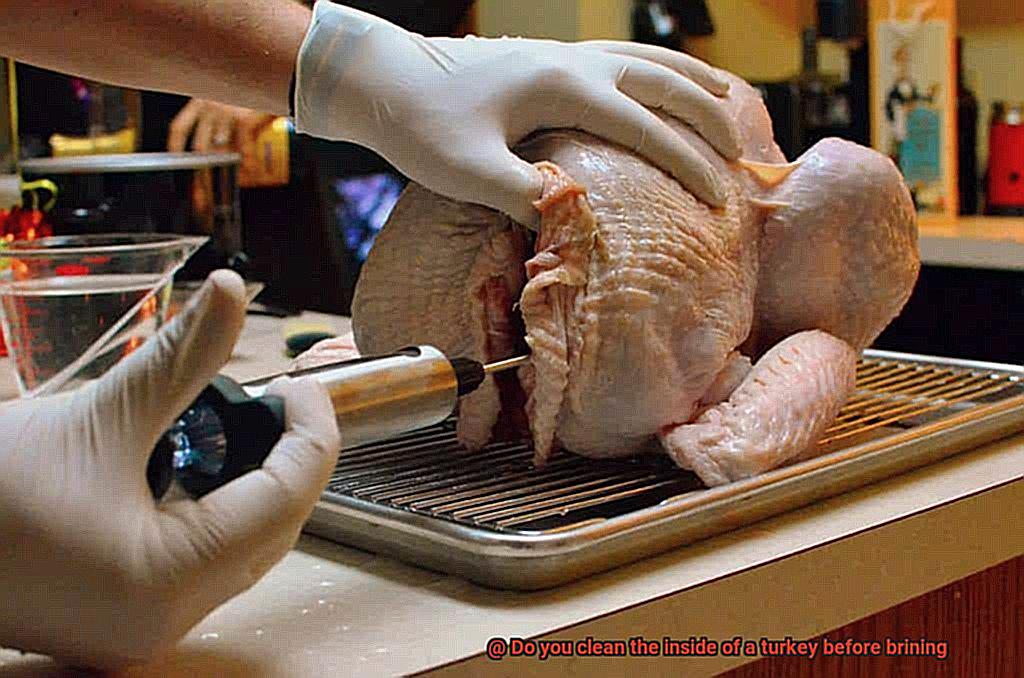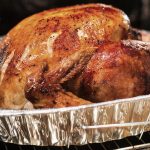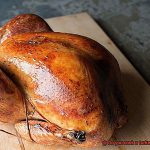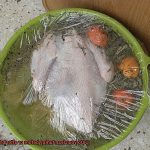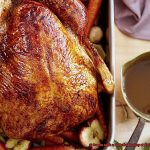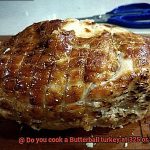Thanksgiving is just around the corner, and it’s time to start planning your turkey. For a lot of people, brining is the key to a juicy, flavorful bird. But before you dunk your turkey into a bucket of brine, there’s an important question that needs answering: do you clean the inside of the turkey before brining?
The debate rages on. Some say cleaning the inside of the turkey is essential to remove any remaining blood, organs, or other residual debris that may have been missed during processing. Not doing so could lead to off flavors, spoilage, or bacteria growth that can cause illness.
But opponents argue that washing the bird can spread bacteria all over your kitchen and increase the likelihood of foodborne illness. They suggest stuffing the bird with aromatics and seasoning the outside is enough to impart flavor to the flesh.
So, what’s a cook to do? In this blog post, we’ll dive deeper into both sides of this argument and help you make an informed decision for your Thanksgiving turkey. Should you clean the inside of your turkey before brining? Let’s find out.
Contents
What is Brining?
Brining is a culinary technique that has been used for centuries to transform ordinary meat into an extraordinary feast. At its core, brining involves soaking meat in a solution of salt and water, along with other ingredients like herbs, spices, sugar, and vinegar. The result is a juicy, flavorful piece of meat that will leave your taste buds begging for more.
One of the primary advantages of brining is that it helps to keep meat moist during cooking. Lean cuts of meat like turkey and chicken can easily dry out, leaving them tough and unappetizing. However, by soaking these meats in a brine solution before cooking, you can ensure that they stay juicy and tender.
The salt in the brine solution plays a crucial role in the process. It alters the protein structure of the meat by breaking down muscle fibers and allowing them to hold onto more moisture. This results in a more flavorful piece of meat that is not dry or tough.
But brining isn’t just about flavor and texture – it’s also about food safety. Brining helps to eliminate any bacteria or impurities that may be present on the surface of the meat. However, it’s important to note that brining alone is not enough to completely eliminate all bacteria and pathogens from meat. You still need to follow proper cooking techniques and food safety practices to ensure that your food is safe to eat.
If you’re preparing a turkey for brining, it’s recommended that you clean the inside of the bird before proceeding with the process. This will help to ensure that any bacteria or contaminants are removed from the cavity of the turkey, preventing foodborne illnesses and ensuring that the turkey is safe to consume.
Should You Clean the Inside of a Turkey Before Brining?
As you gear up for your next family feast, the question of whether or not to clean the inside of your turkey before brining may be on your mind. It’s a common debate amongst culinary enthusiasts, with some arguing that it’s a necessary precaution for food safety, while others contend that it can compromise the flavor and texture of the meat. So, what’s the answer?
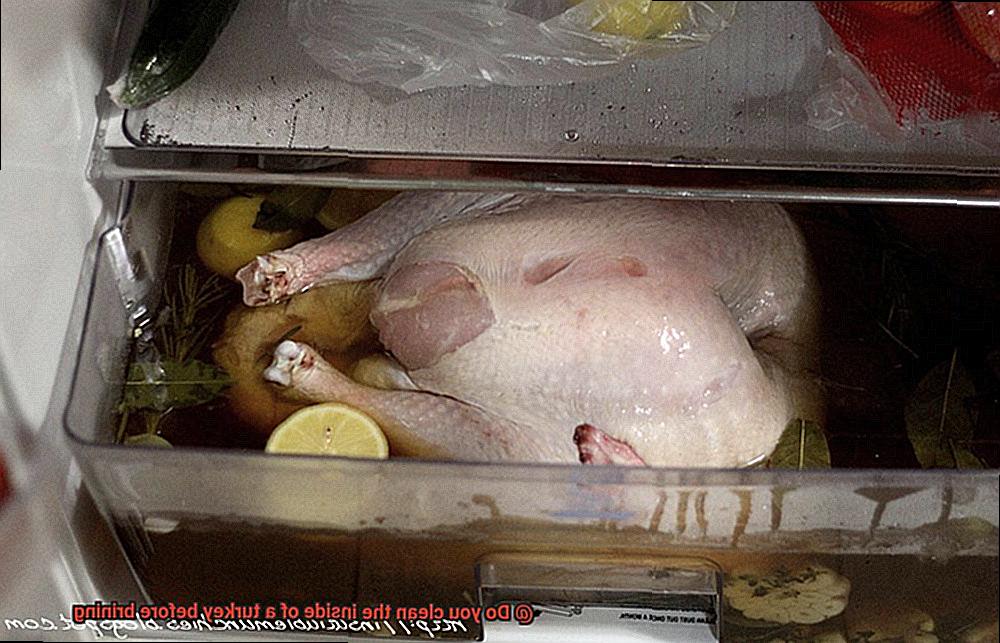
Before we dive into the pros and cons of cleaning your turkey, it’s important to note that all commercially produced turkeys are inspected and cleaned by the USDA before they’re sold to consumers. This means that the inside of the bird has already been thoroughly cleaned, and any remaining feathers, organs, or other parts have been removed.
However, if you’re still concerned about any potential bacteria or debris, some people opt to clean the inside of their turkey before brining. If you choose to do so, make sure to use cold water and thoroughly remove any remaining bits of organs or debris.
But here’s the catch: washing the inside of your turkey can also remove some of its natural juices and flavors. Additionally, if you plan on stuffing your bird, washing it can increase the risk of bacterial contamination as water can get trapped in any crevices or folds in the skin.
So, ultimately, whether or not to clean the inside of your turkey is a matter of personal preference. To help you weigh your options, here are some key points to consider:
- Cleaning your turkey before brining is an extra precaution for food safety reasons.
- The inside of commercially produced turkeys has already been inspected and cleaned by professionals.
- Cleaning the inside can strip away natural juices and flavors from the meat.
- Washing the inside can increase the risk of bacterial contamination if you plan on stuffing your bird.
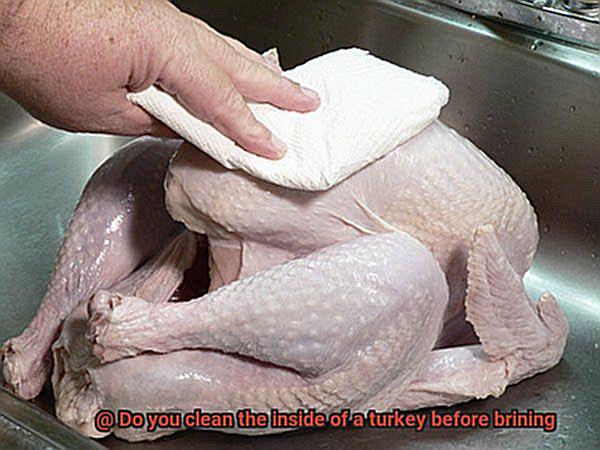
Reasons to Clean the Inside of a Turkey Before Brining
Brining a turkey is the perfect way to infuse it with flavor and make it tender. But before you start preparing your brine, there’s an essential step you must take – cleaning the inside of the turkey. Here are five reasons why it’s important to do so:
Ensures food safety
The inside of a turkey can harbor bacteria and other contaminants that can lead to foodborne illnesses. To prevent this, you must thoroughly clean the cavity before brining. This includes removing the organs like giblets, liver, and heart, which can affect the flavor of the meat and pose a health risk if left inside.
Improves flavor and texture
Cleaning the inside of a turkey also helps to preserve its natural flavor and texture. Any residual bits of tissue or fluids left inside can break down the meat over time, resulting in an unpleasant texture. By cleaning out the cavity, you can help ensure that your bird tastes great and has a pleasing texture.
Allows for even brining
If there’s any excess fat or blood left inside the turkey, it can prevent the brine from penetrating evenly throughout the meat. This can result in uneven flavor or texture, making some parts of the bird too salty while others remain bland. By cleaning the cavity thoroughly, you can ensure that every part of the turkey receives an even soak in the brine.
Helps prevent greasiness
Any excess fat or blood left inside the turkey can also cause it to become too greasy when cooking. This can make it unappetizing to eat and leave an unpleasant taste in your mouth. Cleaning the cavity beforehand can help prevent this from happening.
Achieves even cooking
Finally, cleaning the inside of a turkey before brining is essential for achieving even cooking. If there are any pockets of fluid or tissue left inside, they can cause uneven cooking and result in dry or undercooked meat. By removing these potential issues before brining, you can help ensure that your bird cooks to perfection.
How to Clean the Inside of a Turkey Before Brining
Preparing a perfect turkey for your Thanksgiving dinner requires several steps, and one of the most important is cleaning the inside of the bird before brining. Properly cleaning the turkey’s cavity helps to remove any harmful bacteria or contaminants and ensures that your turkey is safe to eat. Here are five simple steps to follow:
Step 1: Remove Giblets and Neck
The first step is to remove the giblets and neck from the cavity. These can be used later to make delicious gravy or stuffing.
Step 2: Rinse with Cold Water
Next, rinse the inside of the turkey thoroughly with cold water. Use a gentle stream of water to wash away any excess blood or other debris that may be present. This also helps to reduce the risk of cross-contamination.
Step 3: Sanitize the Cavity
After rinsing, sanitize the cavity using a mixture of one part white vinegar to three parts water. Pour this solution into the cavity and let it sit for a few minutes before rinsing it out with cold water again. This will help to kill off any remaining bacteria or contaminants.
Step 4: Pat Dry
Once you’ve sanitized the cavity, pat it dry with paper towels. This will help to remove any excess moisture, which can lead to uneven cooking.
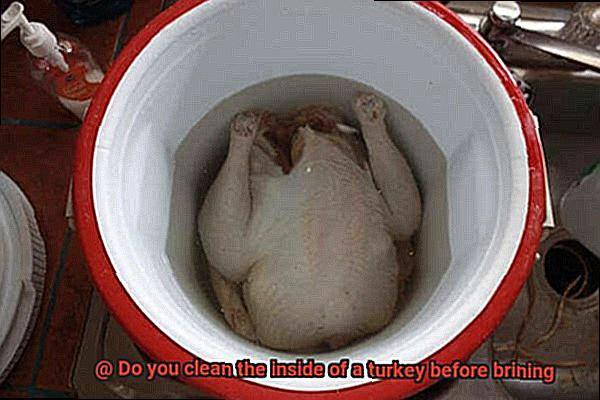
Step 5: Inspect for Debris
Finally, inspect the cavity for any leftover feathers or other debris. Use tweezers or poultry scissors to remove them carefully.
Benefits of Cleaning the Inside of a Turkey Before Brining
Well, the secret to achieving a succulent and safe bird lies in cleaning the inside of the turkey before brining it. This essential step should never be overlooked, as it offers numerous benefits that will transform your turkey into a culinary masterpiece.
Firstly, cleaning the inside of a turkey is crucial to remove any bacteria or contaminants that may be present. This is especially important if your turkey has been frozen, as bacteria can grow in the thawed juices and cavities. By thoroughly cleaning out every nook and cranny, you can reduce the risk of food poisoning and ensure the safety of your loved ones.
In addition to safety, cleaning the inside of a turkey before brining eliminates any unpleasant odors or flavors. The cavity of a turkey can contain remnants of blood, fecal matter, or other unappetizing substances that can affect the taste and smell of the meat. Nobody wants their Thanksgiving meal to smell or taste funky. By cleaning it out thoroughly, you can ensure that your turkey tastes and smells fresh and delicious.
Lastly, cleaning the inside of a turkey allows for maximum penetration of the brine into the meat. The salt in the brine helps to break down proteins in the meat, making it more tender and flavorful.
However, if there are any impediments to this process, such as blood or other debris in the cavity, then the brine may not be able to penetrate as deeply, resulting in less flavorful meat. By cleaning out the cavity thoroughly, you allow for optimal absorption of flavors throughout the bird.
Alternatives to Cleaning the Inside of a Turkey Before Brining
There are alternative options that can still ensure a safe and scrumptious outcome.
One simple alternative is to rinse the outside of the turkey with cold water and pat it dry with paper towels. This will remove any excess blood or fluids without disturbing the inside of the bird.
For those looking for a more thorough option, consider using a vinegar or lemon juice solution to sanitize the turkey before brining. Submerge the turkey in a mixture of 1 cup vinegar or lemon juice with 1 gallon of cold water for 10-15 minutes, then rinse with cold water and pat dry before proceeding with the brining process.
While some may consider skipping cleaning altogether, it may not be recommended for those with weakened immune systems or pregnant women. It’s always better to err on the side of caution when it comes to food safety.
ICIvWJLiL5c” >
Conclusion
In conclusion, the debate over whether or not to clean the inside of a turkey before brining is ongoing. While some argue that it can compromise the flavor and texture of the meat, opponents argue that it’s necessary for food safety reasons. However, cleaning the cavity before brining has numerous benefits.
Firstly, cleaning the inside of your turkey helps to remove any harmful bacteria or contaminants, ensuring that your bird is safe to eat. Additionally, it preserves its natural flavor and texture by removing any residual bits of tissue or fluids left inside. This allows for even brining, prevents greasiness and ultimately results in perfectly cooked meat.
If you choose to clean your turkey before brining, follow these simple steps: remove giblets and neck, rinse with cold water, sanitize the cavity with a vinegar solution, pat dry with paper towels and inspect for debris. While there are alternatives such as rinsing the outside of the bird with cold water or using a vinegar or lemon juice solution to sanitize it, it’s always better to err on the side of caution when it comes to food safety.
Ultimately, whether or not you choose to clean your turkey before brining is a matter of personal preference. However, taking the time to clean your bird beforehand can result in a delicious and safe meal for all.

